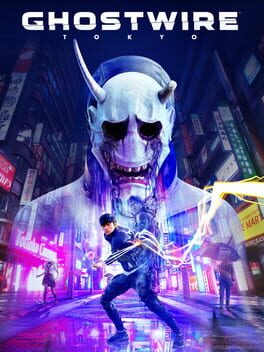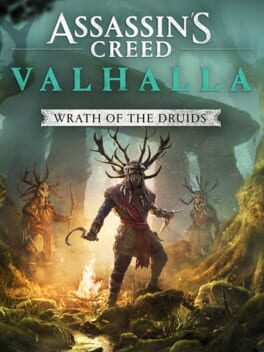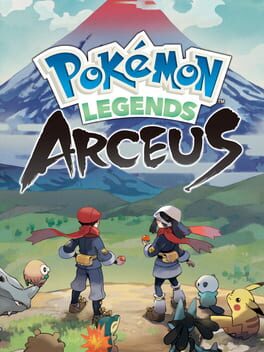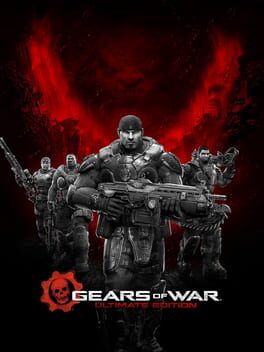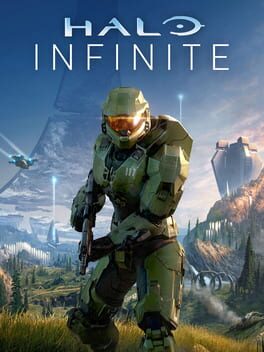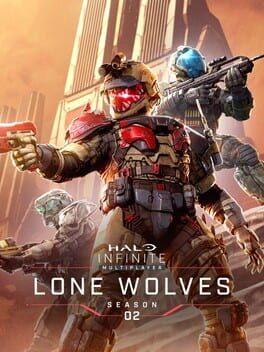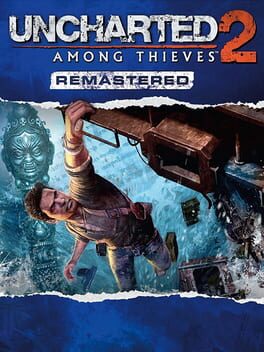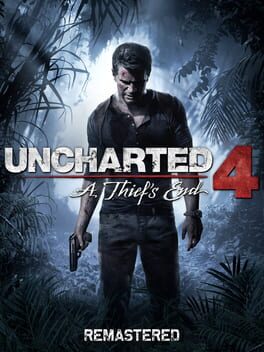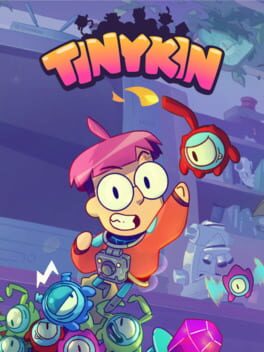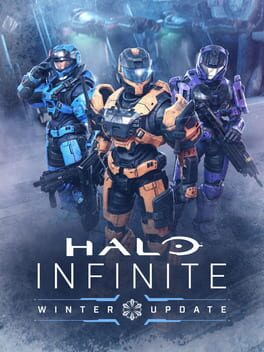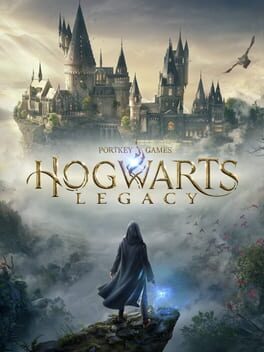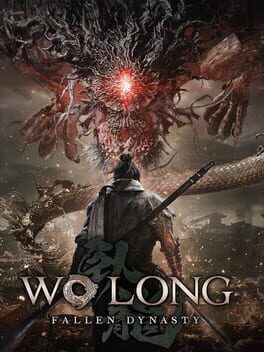ARW3
BACKER
2022
Ghostwire Tokyo is a good open world jaunt that has memorable atmosphere, stylish combat, and pays great homage to Japanese folklore. Perhaps the biggest flaw of Ghostwire Tokyo is that there is simply "too much" of it. Tokyo's emptiness is haunting and serves the tone of the game, but the copy-pasted open world activities within it reach a point of being laborious, non-contributory bloat. The combat, which is overall very enjoyable, also suffers from "too much" - encounters are dragged out by bullet sponging enemies (especially DLC ones) and long animations. Still, many of the side quests are actually quite interesting. The story too is enjoyable enough, and the overall package is easy to recommend. The Spiders-Thread Update adds an excellent side quest chain in the game (starting with "Fear the Children"). This quest chain was amongst my favorites that Ghostwire offered me, and served as a reminder that although Ghostwire is not a horror game... Tango still can do horror well. The second side quest added is a forgettable collectathon type mission.
Ghostwire Tokyo does not evolve the Ubisoft-style open world formula, however it is a worthy adventure for fans of the genre. The experience is elevated by an intriguing realization of Japanese folklore, a unique premise, and flashy hand-weaving combat.
Ghostwire Tokyo does not evolve the Ubisoft-style open world formula, however it is a worthy adventure for fans of the genre. The experience is elevated by an intriguing realization of Japanese folklore, a unique premise, and flashy hand-weaving combat.
A decent addition to Eivor's story, providing more of AC Valhalla's core gameplay loop without too much new variation. In fact, some aspects of the campaign are repetitive in that they mirror activities that push the base-game's campaign forward. It tells a serviceable tale set in an interesting period of Irish history, with clever incorporation of notable historic figures. 9th Century Ireland is beautifully brought to life in "Wrath of the Druids," from the Giant's Causeway to Dublin's harbor.
Not Breath of the Wild, but certainly a breath of fresh air for this franchise. This game provided a well-realized, albeit technically limited, hub-based world that gave individual Pokémon personality like they've never had before. It was a fascinating game of 'exploration,' where the pure turn-based combat of the series takes a bit of a backburner. There was a solid sense of danger with exploration, also novel for the series, and the Pokédex challenge never before felt so rewarding for those curious enough to tackle it
2022
Pentiment is a phenomenal achievement in narrative presentation and depth. Josh Sawyer's passion project is filled with unrivaled respect for the many practices, pitfalls, and perspectives that contribute to historical interpretation.
The title of the game itself invokes its thematic nature. Masterfully, Pentiment peels back the layers of Tassing's complicated past over the course of its expertly paced story, just as one might peel back the superficial layer of a painting only to discover a concealed image beneath it. This fictional town could not be better realized and serves as a perfect backdrop for the disturbing series of events that break its apparent peace. Art, music, costume, dialogue and customs of 16th century Bavaria are lovingly brought to life in Pentiment. The lives of Tassing's townsfolk feels organically contextualized and believable, whether they be clergy, peasants, nobles, hermits or professionals. The attention to detail in this game is frankly staggering. Whether it be the encyclopedia of readily accessible historical information or subtle changes in font Pentiment employs to indicate the perceived intelligence of a speaker, there is an impressive effort to constantly teach the player more about the world they are exploring. Andreas Maler serves as the primary protagonist for this game. Beginning as a journeyman artist, you follow him throughout his lifetime as Tassing progresses through time, hardship, and mystery. His perspective is often purposefully equivocal, allowing room for the player to bring their own interpretations to the narrative that unfolds. Additional player agency is delivered via various "backgrounds" and "studies" we can ascribe to Maler. These provide a surprising variety of interesting tools for navigating conversations throughout Pentiment. However, Maler's core beliefs are realized in such a way where it grows easy to become attached to this complicated, imperfect character.
Pentiment pushes the player forward on a compelling narrative path that gives ample space for personal reflection. Thematically, this game is wonderfully ambiguous. It delves into the nuance of meaningful decision-making and the impossible choices perfectly ordinary humans may be faced with, shattering perspectives of "good vs. bad" that we so often see in video game narratives. Assuredly, players will see the profound downstream effects of their actions and choices. The uncertainty behind every answer the player provides is reflective of the time period it is set, and for the uninitiated Pentiment strives to give context to the great social upheavals seen in 16th century Europe. The intricacies of social class, religion, tradition and other integral aspects of society are not spoken of in concrete terms. Pentiment speaks to the human condition as it relates to the faithful interpretation of the historical setting in which it is set. It explores personal legacy by questioning how we develop, pursue or define our dreams, ambitions and happiness. Most uniquely, Pentiment challenges how we view history… it asks us to think more critically about how the history of a place or a group of people becomes known. It asks us to consider how the interpretation of that history alters over time. Of course, it also inquires about how and to what extent our history should be preserved for future generations.
Although not a historian myself, I hold a Bachelor's of Art in History and have a great deal of love for the frameworks we utilize to study the past. Pentiment, in my opinion, is a near-perfect love letter to the subject's strengths, challenges, and values to society. It won't be a game that appeals to everyone, as is the case with most side-scrolling narrative adventures void of combat encounters or striking 3D visuals. For me, it provided what might just be one of my favorite gaming experiences I've ever had.
The title of the game itself invokes its thematic nature. Masterfully, Pentiment peels back the layers of Tassing's complicated past over the course of its expertly paced story, just as one might peel back the superficial layer of a painting only to discover a concealed image beneath it. This fictional town could not be better realized and serves as a perfect backdrop for the disturbing series of events that break its apparent peace. Art, music, costume, dialogue and customs of 16th century Bavaria are lovingly brought to life in Pentiment. The lives of Tassing's townsfolk feels organically contextualized and believable, whether they be clergy, peasants, nobles, hermits or professionals. The attention to detail in this game is frankly staggering. Whether it be the encyclopedia of readily accessible historical information or subtle changes in font Pentiment employs to indicate the perceived intelligence of a speaker, there is an impressive effort to constantly teach the player more about the world they are exploring. Andreas Maler serves as the primary protagonist for this game. Beginning as a journeyman artist, you follow him throughout his lifetime as Tassing progresses through time, hardship, and mystery. His perspective is often purposefully equivocal, allowing room for the player to bring their own interpretations to the narrative that unfolds. Additional player agency is delivered via various "backgrounds" and "studies" we can ascribe to Maler. These provide a surprising variety of interesting tools for navigating conversations throughout Pentiment. However, Maler's core beliefs are realized in such a way where it grows easy to become attached to this complicated, imperfect character.
Pentiment pushes the player forward on a compelling narrative path that gives ample space for personal reflection. Thematically, this game is wonderfully ambiguous. It delves into the nuance of meaningful decision-making and the impossible choices perfectly ordinary humans may be faced with, shattering perspectives of "good vs. bad" that we so often see in video game narratives. Assuredly, players will see the profound downstream effects of their actions and choices. The uncertainty behind every answer the player provides is reflective of the time period it is set, and for the uninitiated Pentiment strives to give context to the great social upheavals seen in 16th century Europe. The intricacies of social class, religion, tradition and other integral aspects of society are not spoken of in concrete terms. Pentiment speaks to the human condition as it relates to the faithful interpretation of the historical setting in which it is set. It explores personal legacy by questioning how we develop, pursue or define our dreams, ambitions and happiness. Most uniquely, Pentiment challenges how we view history… it asks us to think more critically about how the history of a place or a group of people becomes known. It asks us to consider how the interpretation of that history alters over time. Of course, it also inquires about how and to what extent our history should be preserved for future generations.
Although not a historian myself, I hold a Bachelor's of Art in History and have a great deal of love for the frameworks we utilize to study the past. Pentiment, in my opinion, is a near-perfect love letter to the subject's strengths, challenges, and values to society. It won't be a game that appeals to everyone, as is the case with most side-scrolling narrative adventures void of combat encounters or striking 3D visuals. For me, it provided what might just be one of my favorite gaming experiences I've ever had.
2021
Best-feeling Halo title since Halo 3. Mechanics are sound and the game launched balanced. Campaign is a complete experience, although launching without co-op hurt the experience. Similarly, multiplayer suffers from a lack of Forge at launch. As far as a foundation goes for a game with a planned long-lifespan, Infinite is strong and I anticipate playing for years to come.
Competes w/ Uncharted 2 as the best in the series. This delivered a compelling story from beginning to end, providing a satisfying end to Nathan Drake's tetralogy. It does a wonderful job of calling back to and referencing Drake's previous ventures. 60+ fps makes the experience super smooth, making up for combat that is improved compared to its predecessors, but still a bit finicky in nature.
2022
Beautifully crafted title. If you enjoy "collectathon" platformers like Psychonauts, this is that with the aesthetic kin to a Bug Fables or Paper Mario... and with core gameplay largely taking inspiration from Pikmin, minus the combat. Tinykin takes a lot of familiar ideas and blends them into a unique and lovable experience that won't demand too much of your time
2019
A Show to Remember:
Persona 5 Royal is simply one of the greatest video games I have ever played. It is stylistic, fun, emotional and supersaturated with an eclectic cast of compelling characters that I grew to love. The environment and art direction proved absolutely stunning. Even the UI oozes style while incorporating a level of practicality that so many JRPGs neglect. As for the OST, words obviously could never do it justice. I adored nearly every single song this game featured, of which there were many. The impressive scope of its original score allowed Atlus to attach even the most mundane of the daily life-sim tasks with a banger track of their own.
Throughout, there is a great attention to detail maintained from beginning to end. In-spite of this being, for some, a 100+ hour video game… it remarkably demands your attention and remains interesting at every turn or twist. The plot near-constantly pivots, to the point where one assumes the next revelation might be the last surprise the game will offer, only to have expectations subverted yet again shortly thereafter. P5R fearlessly tugs at players' heartstrings and cleverly rewards your diligence as you guide Joker's journey. Common writing tropes are addressed head-on, and are often sarcastically rejected in favor of Atlus' own witty dialogue. The narrative pay-outs, both from the major and minor story beats, are sublime. Daily life will change gradually and scripted events are well-placed through the progression of P5R's in-game calendar, granting players familiarity without monotony. I took my time with Persona 5 Royal, putting over 130 hours into the game before completing it. While this sort of commitment is certainly not required for enjoyment, it was additive to my own experience as I built personal rapport with P5R's characters, world, and narrative. The combat felt like a fresh and evolved version of the turn-based combat I first encountered playing Japanese role-playing games in my youth. Fusing, sacrificing, developing and capturing new personas prompted more frequent adoption of novel combat strategies. As a result, combat remained fresh for the duration of my playthrough. The "confidant" system for hanging out with your companions works excellently to give players' stake in the lives of Joker's numerous allies. Joker himself was as phenomenal a RPG protagonist as you could ask for. He was calm, cool, collected and recurrently put everything on the line to uphold his ideals. Every second with this game felt like time well spent. P5R will be a game I feel comfortable recommending to any and all in the years to come.
This was my first Persona game, but I believe it will not be my last. The mask might be thrown away for now, but I plan to engross myself in the worlds of Persona 3 Portable and Persona 4 Golden... while also earnestly awaiting the global take over that will ensue with the reveal of Persona 6. This game succeeded in stealing my heart, that much is for sure.
Persona 5 Royal is simply one of the greatest video games I have ever played. It is stylistic, fun, emotional and supersaturated with an eclectic cast of compelling characters that I grew to love. The environment and art direction proved absolutely stunning. Even the UI oozes style while incorporating a level of practicality that so many JRPGs neglect. As for the OST, words obviously could never do it justice. I adored nearly every single song this game featured, of which there were many. The impressive scope of its original score allowed Atlus to attach even the most mundane of the daily life-sim tasks with a banger track of their own.
Throughout, there is a great attention to detail maintained from beginning to end. In-spite of this being, for some, a 100+ hour video game… it remarkably demands your attention and remains interesting at every turn or twist. The plot near-constantly pivots, to the point where one assumes the next revelation might be the last surprise the game will offer, only to have expectations subverted yet again shortly thereafter. P5R fearlessly tugs at players' heartstrings and cleverly rewards your diligence as you guide Joker's journey. Common writing tropes are addressed head-on, and are often sarcastically rejected in favor of Atlus' own witty dialogue. The narrative pay-outs, both from the major and minor story beats, are sublime. Daily life will change gradually and scripted events are well-placed through the progression of P5R's in-game calendar, granting players familiarity without monotony. I took my time with Persona 5 Royal, putting over 130 hours into the game before completing it. While this sort of commitment is certainly not required for enjoyment, it was additive to my own experience as I built personal rapport with P5R's characters, world, and narrative. The combat felt like a fresh and evolved version of the turn-based combat I first encountered playing Japanese role-playing games in my youth. Fusing, sacrificing, developing and capturing new personas prompted more frequent adoption of novel combat strategies. As a result, combat remained fresh for the duration of my playthrough. The "confidant" system for hanging out with your companions works excellently to give players' stake in the lives of Joker's numerous allies. Joker himself was as phenomenal a RPG protagonist as you could ask for. He was calm, cool, collected and recurrently put everything on the line to uphold his ideals. Every second with this game felt like time well spent. P5R will be a game I feel comfortable recommending to any and all in the years to come.
This was my first Persona game, but I believe it will not be my last. The mask might be thrown away for now, but I plan to engross myself in the worlds of Persona 3 Portable and Persona 4 Golden... while also earnestly awaiting the global take over that will ensue with the reveal of Persona 6. This game succeeded in stealing my heart, that much is for sure.
Halo Infinite "Winter Update" showcases what a live-service Halo game could be if production came close to firing on all cylinders. The new head of live service, Sean Baron, has given Halo fans the first glimpse at the direction he wishes to steer the ship. Progression in Infinite feels appropriate, and the frustrating challenge system has been overhauled to be less important, less time-consuming, and most importantly less demanding that players alter their playstyles. Playlist agnostic challenges and the reduction of the weekly challenge count make the experience of progressing or earning weekly cosmetics much more enjoyable. The newly implemented "Match XP" system, separate from challenges, already feels well-tuned in its initial form. It is also encouraging to hear from 343i that the overall career system development is progressing well and should debut in 2023.
Satisfied with their ability to get kinks worked out over time, Sean green-lit the launch of the Custom Games Browser >3 months earlier than its initial ETA. This, in tandem with the advent of Halo's most expansive Forge offering ever, has breathed new life into Halo Infinite. The return of classics like Lockout, Blood Gulch, and Guardian ring all the right nostalgic bells. Duck hunt, Castle Wars and obstacle courses make their rightful return to Halo and are accompanied by novel sandbox zaniness that display the player-led innovation paramount to Infinite's longevity (shout-out to "Digletts").
Player feedback appeared tantamount to the marketing of the Winter Update: free Reach-inspired cosmetics including Emile's infamous shoulder pieces, a robust file sharer coinciding with Forge's release, a polished rendition of campaign co-op, 3 new maps for arena (all crafted in Forge), scattered community events (I.e. Winter Contingency vol II), and the previously mentioned alterations to the progression system. The promise to incorporate Forge maps into matchmaking furthers the appeal of the multiplayer going forward. Already, the remake of Halo 3's "The Pit" is a welcome addition to Infinite's growing map sandbox.
There are still more items on the docket for Halo Infinite's multiplayer, which feel more achievable now: ongoing resolution of de-sync issues takes technical-precedent, while on the content side of things new BTB maps and the new equipment/weapons promised for Season 3 are in higher demand. Infinite's most glaring omission at this point are its absent game modes. Even with Forge tools in-hand, players remain without official access to Griffball, Infection, Assault, and others. Lastly, of course, the game will also benefit from the rumored Battle Royale-like mode rumored to be in development with Certain Affinity.
With Halo Infinite's co-op fully functional at this point, although without split screen options, I hope that Joseph Staten's crew at 343i will turn their attention to the continuation of Infinite's campaign. Whether "The Endless," or an equivalent story DLC, comes by way of expansion or a spin-off game in the same engine (like O.D.S.T.)... I am eager to see where Chief goes next. In revisiting the campaign this Winter, I was once again reminded how captivating it was in setting up the future of the franchise: many stories and characters remain in limbo. There are also still plenty of foes present to challenge Chief on the Zeta Halo Ring.
I believe Halo Infinite is on the right track, and I remain keen to see what awaits us in Season 3 (slated for March 7, 2023) and beyond.
Satisfied with their ability to get kinks worked out over time, Sean green-lit the launch of the Custom Games Browser >3 months earlier than its initial ETA. This, in tandem with the advent of Halo's most expansive Forge offering ever, has breathed new life into Halo Infinite. The return of classics like Lockout, Blood Gulch, and Guardian ring all the right nostalgic bells. Duck hunt, Castle Wars and obstacle courses make their rightful return to Halo and are accompanied by novel sandbox zaniness that display the player-led innovation paramount to Infinite's longevity (shout-out to "Digletts").
Player feedback appeared tantamount to the marketing of the Winter Update: free Reach-inspired cosmetics including Emile's infamous shoulder pieces, a robust file sharer coinciding with Forge's release, a polished rendition of campaign co-op, 3 new maps for arena (all crafted in Forge), scattered community events (I.e. Winter Contingency vol II), and the previously mentioned alterations to the progression system. The promise to incorporate Forge maps into matchmaking furthers the appeal of the multiplayer going forward. Already, the remake of Halo 3's "The Pit" is a welcome addition to Infinite's growing map sandbox.
There are still more items on the docket for Halo Infinite's multiplayer, which feel more achievable now: ongoing resolution of de-sync issues takes technical-precedent, while on the content side of things new BTB maps and the new equipment/weapons promised for Season 3 are in higher demand. Infinite's most glaring omission at this point are its absent game modes. Even with Forge tools in-hand, players remain without official access to Griffball, Infection, Assault, and others. Lastly, of course, the game will also benefit from the rumored Battle Royale-like mode rumored to be in development with Certain Affinity.
With Halo Infinite's co-op fully functional at this point, although without split screen options, I hope that Joseph Staten's crew at 343i will turn their attention to the continuation of Infinite's campaign. Whether "The Endless," or an equivalent story DLC, comes by way of expansion or a spin-off game in the same engine (like O.D.S.T.)... I am eager to see where Chief goes next. In revisiting the campaign this Winter, I was once again reminded how captivating it was in setting up the future of the franchise: many stories and characters remain in limbo. There are also still plenty of foes present to challenge Chief on the Zeta Halo Ring.
I believe Halo Infinite is on the right track, and I remain keen to see what awaits us in Season 3 (slated for March 7, 2023) and beyond.
2023
This game is brilliant on many levels. Everything pulsates to its beat: enemy attacks, the player's idle animations, environmental objects, obstacles, parries or actions in a cutscene… the combat, while demanding a steep learning curve, can feel absolutely sublime when you become in-sync with the world around you… and what a world it is. The cel-shaded art style of Hi-Fi Rush is simply gorgeous and teeming with untamed creativity. For a linear game, the environments are dense and often mesmerizing. The game will show-off the sheer polish in its animation work by cleverly playing with perspective or seamlessly transitioning in and out of 3D action to a beautiful comic-like cutscene… all without missing a beat. The combat too strives to the march of the beat, but does well to not overly punish you when you stray from perfect rhythm. Instead, the combat concerns itself more with positive reinforcement. Subtle tones and musical queues will accompany extra powerful attacks when melee strikes are executed on beat. Hi-Fi Rush constantly layers its mechanics as the game progresses and new enemy types join the battlefield. What starts as a simple rhythm combat game rapidly ramps up to a chaotic concert of Devil May Cry inspired action combat with combinations galore, partner attacks, grapple-hooking, dodges, parries, and more. This game encourages mastery of its complex combat systems, offering players a huge array of endgame content and mission replayability options after credits have rolled on this fairly tight, well-paced experience. There are upgrades to find, novel challenge encounters to play, easter eggs to uncover, high-scores to achieve and a staggering list of challenges to pursue in the post-game. The easter eggs are particularly charming, with references galore. The content of these nods include ranging inspiration from their own Evil Within games, other titles like Yakuza or Persona 5, and even Katy Perry's Super Bowl performance... the outside allusions always put a smile on my face. Of-course, this all works from a practical perspective thanks in-no-small-part to how refreshingly polished this title is at launch. My 18 hours of the game were flawless in terms of performance and stability.
Combat finds a way to remain satisfying and fresh throughout, as the game demands more finesse and coordinated use of the tools it has provided players. Scattered throughout the campaign, as a breakup from normal combat, are lavish boss fights. Often, they are a visual spectacle with masterclass animation-work. No two bosses fight the same, and each features its own musical track (often licensed) to elevate the experience. The music choices here absolutely slap. Hi-Fi Rush makes excellent use of some licensed music, featuring the likes of Nine Inch Nails, The Black Keys, and The Joy Formidable (the lattermost contributes a song overlying my favorite level, or "track," of the game). That being said, the OST for this game is similarly excellent, and I'd argue the "Streamer Mode" is on parity with the default music mode. The Glass Pyramids' contributions are absolute fire - "The Beacon" and "Synesthesia" were favorites tracks of mine. Chai, 808 and the rest of his accomplices are an absolutely lovable, goofy set of characters. Robbie Daymond, Erica Lindbeck, Roger Craig Smith and the rest of the voice artists are splendid throughout. For a game so irreverent and characterized by its witty, silly and pun-laden banter… the voice artists and writers work in tandem to deliver on some strong emotional beats when the set is right for it. The narrative does not strive for over-complexity, but instead focuses on an endearing character-driven adventure filled with more heart than you can imagine.
You can apply that last statement to Hi-Fi Rush as a whole… Kai, 808 and crew may have entered the limelight seemingly overnight, courtesy of this game's shadow-drop release, but I expect we will see them again and that they will be celebrated for years to come. Tango Gameworks outdid themselves here. This traditionally horror-focused studio just released one of the most vibrant and uplifting titles we've ever seen from a first-party AAA developer. This might be their first foray in the action-adventure or rhythm-based genre, but they've knocked it out of the park with Hi-Fi Rush. It is joyous, charismatic, and unequivocally fun. I hope that this week John Johanes and his team are celebrating like they just dropped a platinum hit on their debut album… I already eagerly look forward to seeing what they do next.
Combat finds a way to remain satisfying and fresh throughout, as the game demands more finesse and coordinated use of the tools it has provided players. Scattered throughout the campaign, as a breakup from normal combat, are lavish boss fights. Often, they are a visual spectacle with masterclass animation-work. No two bosses fight the same, and each features its own musical track (often licensed) to elevate the experience. The music choices here absolutely slap. Hi-Fi Rush makes excellent use of some licensed music, featuring the likes of Nine Inch Nails, The Black Keys, and The Joy Formidable (the lattermost contributes a song overlying my favorite level, or "track," of the game). That being said, the OST for this game is similarly excellent, and I'd argue the "Streamer Mode" is on parity with the default music mode. The Glass Pyramids' contributions are absolute fire - "The Beacon" and "Synesthesia" were favorites tracks of mine. Chai, 808 and the rest of his accomplices are an absolutely lovable, goofy set of characters. Robbie Daymond, Erica Lindbeck, Roger Craig Smith and the rest of the voice artists are splendid throughout. For a game so irreverent and characterized by its witty, silly and pun-laden banter… the voice artists and writers work in tandem to deliver on some strong emotional beats when the set is right for it. The narrative does not strive for over-complexity, but instead focuses on an endearing character-driven adventure filled with more heart than you can imagine.
You can apply that last statement to Hi-Fi Rush as a whole… Kai, 808 and crew may have entered the limelight seemingly overnight, courtesy of this game's shadow-drop release, but I expect we will see them again and that they will be celebrated for years to come. Tango Gameworks outdid themselves here. This traditionally horror-focused studio just released one of the most vibrant and uplifting titles we've ever seen from a first-party AAA developer. This might be their first foray in the action-adventure or rhythm-based genre, but they've knocked it out of the park with Hi-Fi Rush. It is joyous, charismatic, and unequivocally fun. I hope that this week John Johanes and his team are celebrating like they just dropped a platinum hit on their debut album… I already eagerly look forward to seeing what they do next.
2023
Hogwarts Legacy is a good game that might just be an amazing game for big Harry Potter fans. PortKey's greatest accomplishment here was how expertly they brought Hogwarts Castle and the surrounding grounds to life. The castle and its surrounds are indeed wonderful and captivating to traverse. There is intrigue at every corner, with interesting lore and conversations to be uncovered. What's more, it is graphically stunning at times, especially around the castle. It is impressive just how much of this world is rendered at any given time, even with some minor loading circles appearing on occasion and pop-in throughout the open world.
The game is whimsical and fantastical in a way that serves it well. The open world design does leave some aspects to be desired, filled with tiresome side quests and a meaninglessly bloated number of collectible tasks (the Merlin Trials being the biggest culprit). Poor dialogue from a majority of the many characters you meet also can be a bummer, but a handful of the main cast (i.e. Poppy Sweeting and Sebastian) are more interesting. The most frustrating aspect of the game, aside from a notable trophy bug preventing me from completing the conjuration collection, is repetitive dialogue. Never again do I want to hear anything from the Foo Flame lady, or any Hogsmeade talk from the protagonist. These flaws are partly remedied by a serviceable story, intriguing companion quests, and a surprising strength: the combat. There is quite a lot of fun that can be had with the combat in Hogwarts Legacy, with a nice spread of spells and combinations at one's disposal. Enemy variety is narrow for such an expansive game, but combat scenarios nonetheless were highlights throughout. Accompanying systems are also strong: broom-riding, beast management, herbology and potion making all can play a significant role in one's playthrough. The game does well to serve multiple play-styles through these systems and accompanying combat skill trees.
Hogwarts Legacy acts as a mesmerizing love letter to the franchise, albeit with a notable, conceited effort in some areas to distinguish itself from the deleterious views' of the IP's creator. All and all, Hogwarts Legacy delivered on the long overdue promise of realizing the Wizarding World into a AAA video game.
The game is whimsical and fantastical in a way that serves it well. The open world design does leave some aspects to be desired, filled with tiresome side quests and a meaninglessly bloated number of collectible tasks (the Merlin Trials being the biggest culprit). Poor dialogue from a majority of the many characters you meet also can be a bummer, but a handful of the main cast (i.e. Poppy Sweeting and Sebastian) are more interesting. The most frustrating aspect of the game, aside from a notable trophy bug preventing me from completing the conjuration collection, is repetitive dialogue. Never again do I want to hear anything from the Foo Flame lady, or any Hogsmeade talk from the protagonist. These flaws are partly remedied by a serviceable story, intriguing companion quests, and a surprising strength: the combat. There is quite a lot of fun that can be had with the combat in Hogwarts Legacy, with a nice spread of spells and combinations at one's disposal. Enemy variety is narrow for such an expansive game, but combat scenarios nonetheless were highlights throughout. Accompanying systems are also strong: broom-riding, beast management, herbology and potion making all can play a significant role in one's playthrough. The game does well to serve multiple play-styles through these systems and accompanying combat skill trees.
Hogwarts Legacy acts as a mesmerizing love letter to the franchise, albeit with a notable, conceited effort in some areas to distinguish itself from the deleterious views' of the IP's creator. All and all, Hogwarts Legacy delivered on the long overdue promise of realizing the Wizarding World into a AAA video game.
Overall, Wo-Long is a pretty good game. It shines during its chaotic combat sequences, bolstered by flashy animations and bombastic boss battles. Boss encounters, character customization, and the "spirit" system all serve as notable strengths for this title. Graphics and level design are sadly quite outdated, yet still yield strangely long loading screens. The game runs fairly well on Xbox Series X, and I personally experienced little technical hurdles and no crashes. Although the minute-to-minute combat is fantastic, it becomes hard to enjoy it with enemy encounters that prioritize cheesy hidden placements of enemies and overall bland enemy variety to unleash your growing skills upon. As one masters the game's parry system, the difficulty becomes manageable and quite rewarding, but it is hard to not grow frustrated as you traverse redundantly designed levels (i.e. draining a moat to enter a monotone tunnel 3+ times in one mission) in hopes of reaching the next exciting boss fight. The morale system, while neat it in concept, is also hindered by the frustrating enemy layouts. Working diligently to raise your morale can easily become instantly negated by some foot-soldier hiding behind a corner, ready to instant hit you with a critical strike just because you so dared as to explore the world. This nerfs you going into the next encounter, and in a way would sometimes discourage me from engaging with the combat system at every chance… despite it being the game's strongest facet. The spirit system, in contrast, is well realized. Balancing overall offense, defense, wizardry, martial arts, and parries while considering your fluctuating spirit bar is a core means by which the combat stays splendidly exciting. This dance shines during boss fights. These boss encounters proved to be a consistent highlight throughout the entirety of the campaign. Although the deflect system is critical to nearly every one of these fights, there are enough differences in visual design and attack patterns for these fights to all prove wonderfully distinct. Fans of fast-paced, challenging combat will most likely enjoy their time with Wo-Long: Fallen Dynasty. For a completionist, this journey's runtime (excluding NG+, and only considering achievements/trophies) will likely fall in the 40-60 hour range for most people.
7.5 / 10
7.5 / 10
